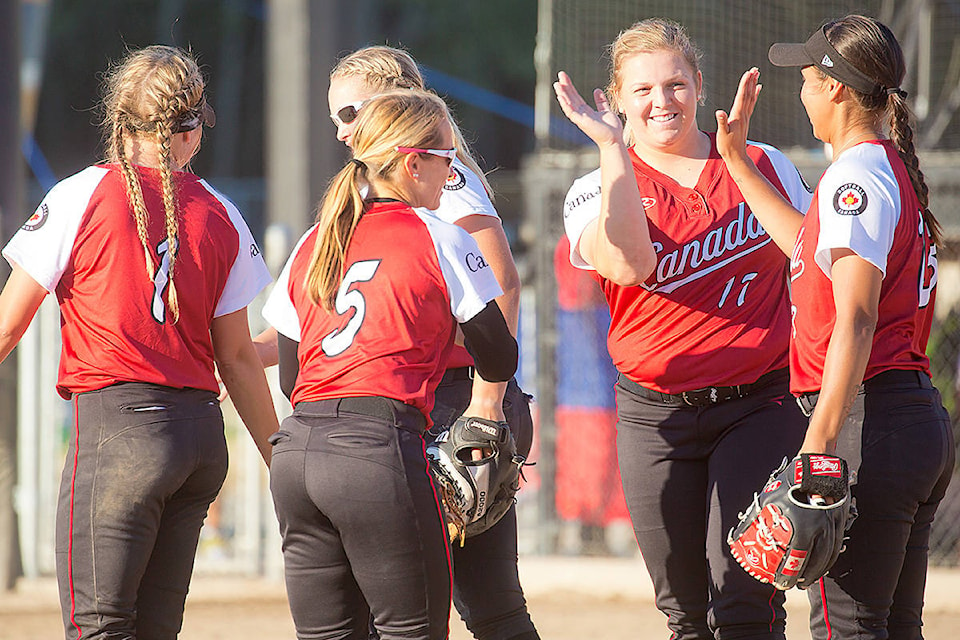Though the host nation was knocked out of championship contention early – and one national team, Pakistan, never showed up at all – the return of the Canada Cup after a seven-year absence was a home run, according to longtime tournament chairperson Greg Timm.
And while the competition was strong on the field – Japan defeated Australia for the women’s title Monday night at Softball City – and ticket sales were as brisk as ever, Timm was most pleased with the support that the event continues to receive from the community.
“We had a fantastic response again, in terms of volunteers, sponsorship, and just the general support of our event,” he told Peace Arch News Tuesday, as he had his legion of 350-plus volunteers worked to put the 10-day fastpitch tournament to bed. “We were really pleased with the results.”
The Canada Cup began in 1993, and with the exception of 1997, was played each July in South Surrey until 2010, when the event was renamed the Canadian Open Fastpitch International Championship. The Open, while still featuring international competition, had more of a focus on youth teams. The event ran in that form until 2016, when it was replaced by the 30-team 2016 Women’s World Softball Championships. At the conclusion of the world tournament last July, organizers announced the Canada Cup moniker would return, and with it, a renewed focus on international play.
This year’s women’s division was back to pre-worlds levels with 11 teams, and Timm said the results compare favourably to the 2015 Canadian Open – which ran from 2010-‘15 – in terms of gate receipts and spectator numbers.
“I haven’t got the exact (ticket) count, but financially, I do know that our gate totals were higher, and our ticket prices were the same (as 2015), so our revenue totals are up. And back then, we had 100,000 people through the park,” he said.
The tournament brought more than 3,000 people into the city, he added – 1,200 athletes, 350 coaches, as well as umpires, team delegates, and family and friends of those taking part.
“There’s a big economic spinoff, and we hope that the community feels it,” he said.
Despite strong overall numbers, there were noticeable downticks in attendance at times during the week depending on when you strolled through the gate of Softball City or Cloverdale Athletic Park, though Timm is quick to point out that many of those moments occurred during midweek day games, when, summer or not, many people are at work.
“We can’t forget that we’re in a bit of a bubble here. When we’re playing ball at Tuesday at two o’clock, it’s still Tuesday at two o’clock, regardless of what teams are playing,” he said.
Canada being knocked from the playoff rounds early Saturday also had an effect on weekend attendance, he noted, though he was also pleased that so many fans came out to cheer on visiting countries with which they had no affiliation.
“We do lose a bit of momentum when Team Canada gets eliminated, and this year they were eliminated on Saturday morning, so that was the end of that, and all the rest of our games Saturday, Sunday and Monday night were played without our national flag flying,” he explained.
“That affects us, but we were really pleased with the crowds throughout the tournament and I think it shows just the depth of support we have. People were out to watch Venezuela and Puerto Rico play – that was a good crowd.”
As evidence of that support, Timm relays a scene he witnessed last week at Softball City, while standing near the front entrance to the park.
“I was standing there as the Venezuelan team was walking in, and there were about 10 or 15 kids on the playground nearby, and the kids, just about in unison, yelled out, ‘Hola!’ to the players,” he said.
“Three minutes later, the Japanese team walks in behind them, and the same kids say, ‘Konnichiwa!’
“Right then, I thought, ‘OK, I think we’re making an impact here.’ That’s when it hit me. And the teams all feel that – that’s why they come here, because they’re treated so well by everyone in the community.”
With the next world championships on the horizon in 2018 – set for Chiba, Japan next summer –and an Olympic return another year closer, Timm said it’s possible that the Canada Cup could be even bigger next year, though he stopped short of making any official proclamations.
Next year’s Canada Cup will run July 13-23, and is the last big tournament on the international calendar before worlds.
“We hope it fits well. We hope teams come and compete here… We hope the European teams will come here and then continue on to Japan; we hope the (North American) teams will come here on the way; and we hope the Asian and Oceanic teams will come here as a warm-up, because this is where the competition is the best,” he said.
“Whether it plays out that way or not, we’ll see. But we can only give it our best shot.”
